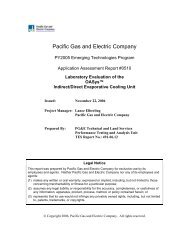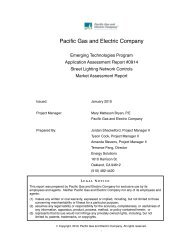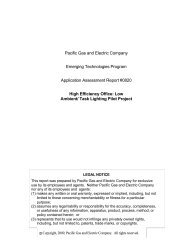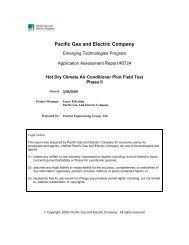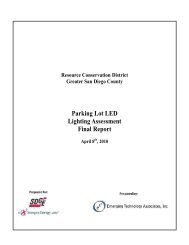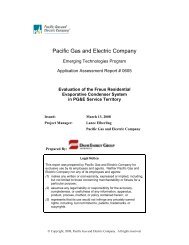PGE Water Heater ET Final Report - FINAL.pdf - Emerging ...
PGE Water Heater ET Final Report - FINAL.pdf - Emerging ...
PGE Water Heater ET Final Report - FINAL.pdf - Emerging ...
You also want an ePaper? Increase the reach of your titles
YUMPU automatically turns print PDFs into web optimized ePapers that Google loves.
PG&E’s <strong>Emerging</strong> Technologies Program <strong>ET</strong>12<strong>PGE</strong>3191<br />
National and local points of reference for water heater programs show the importance of<br />
collaborating with channel partners to:<br />
bring the highest price reduction possible to the customer;<br />
have of high percentage of ENERGY STAR qualified water heaters in stock;<br />
inform customers about limited time opportunities to participate in a program.<br />
BARRIERS TO ENERGY STAR WATER HEATER SALES<br />
Fundamentally, the barriers to increasing sales of ENERGY STAR water heaters in PG&E’s<br />
service territory are supply and demand. Retailers and manufacturers currently do not<br />
perceive that there is sufficient consumer demand for qualifying water heaters.<br />
Consequently they have exerted minimal efforts to stock these models. At the same time,<br />
consumers do not perceive the sum total of benefits from an efficient water heater justify its<br />
price and the transaction costs.<br />
In a rational economic market, an appropriate water heater price should drive desired levels<br />
of supply and demand, but today’s high prices only satisfy the needs of a small segment of<br />
consumers and limit the availability of qualified products. Utility intervention with financial<br />
incentives is one requirement for expanding the market for ENERGY STAR water heaters.<br />
Four factors are embedded in this supply and demand conundrum that accentuates market<br />
barriers: High Percentage of Purchase Decisions is Emergency Decisions, Channel<br />
Indifference to High Efficiency Products, “Out-of-Sight-Out-of-Mind” Purchases, and<br />
Regulatory Requirements.<br />
High Percentage of Purchase Decisions is Emergency Decisions<br />
Almost two-thirds of water heater purchases are undertaken because of some kind of<br />
emergency, Figure 12. Decision making for water heater purchases does not follow the<br />
ideal economic model because homeowners view hot water as an essential commodity and<br />
often make sub-optimal decisions in an emergency when a water heater has failed. From<br />
the consumer’s perspective, the least risky decision in an emergency situation is to replace<br />
a failed water heater with a nearly identical one. Fortunately, most water heater failures<br />
are not catastrophic and purchase decisions need not be instantaneous. Intervention at the<br />
point of purchase is necessary to explain the near term and long term benefits associated<br />
with an energy efficient product purchase. The sales person has to be equipped with<br />
adequate messaging to simplify the discussion of higher efficiency alternatives and eliminate<br />
confusion about water heaters.<br />
Channel Indifference to High Efficiency Products<br />
Sales will always come down to price and “what is on-the-truck or in-stock”. A retailer’s or<br />
distributor’s product assortment and stocking decisions are based on what has been selling<br />
and what the anticipated consumer buying behavior will be in the near future. Stocking is<br />
not done on hope and speculation because there is a cost associated with carrying inventory<br />
and displaying products. <strong>Water</strong> heaters are expensive to display and inventory because of<br />
their sheer bulk. Once a water heater is out of the box and on-display, it then becomes a<br />
used product, cannot be sold as new, and causes a financial loss. Retailers and distributors<br />
seek profits and market share and are indifferent to a specific product feature if it does not<br />
contribute to these business objectives. Thus, utility interventions to increase demand for<br />
high efficiency products or to stock a greater number of efficient models are needed to<br />
cease the perpetuation of trucks and stores stocked with inefficient, non-complying<br />
products.<br />
36



